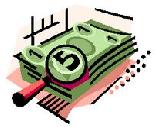
 |
|
| Financial Terms | |
| Sale and lease-back |
|
Information about financial, finance, business, accounting, payroll, inventory, investment, money, inventory control, stock trading, financial advisor, tax advisor, credit.
Main Page: financial advisor, business, finance, money, inventory, payroll, tax advisor, stock trading, |
Definition of Sale and lease-back
Sale and lease-backsale of an existing asset to a financial institution that then leases it back to the user.
Related Terms:Limitation on sale-and-leasebackA bond covenant that restricts in some way a firm's ability to enter into Sale and LeasebackAn agreement in which the owner of a property sells that property to a person or institution and then leases it back again for an agreed period and rental. Asset-backed securityA security that is collateralized by loans, leases, receivables, or installment contracts Back feeThe fee paid on the extension date if the buyer wishes to continue the option. Back officeBrokerage house clerical operations that support, but do not include, the trading of stocks and Back-to-back financingAn intercompany loan channeled through a bank. Back-to-back loanA loan in which two companies in separate countries borrow each other's currency for a  Back-up1) When bond yields and prices fall, the market is said to back-up. BackwardationA market condition in which futures prices are lower in the distant delivery months than in Best-efforts saleA method of securities distribution/ underwriting in which the securities firm agrees to sell Break-even lease paymentThe lease payment at which a party to a prospective lease is indifferent between Buy-backAnother term for a repo. Capital leaseA lease obligation that has to be capitalized on the balance sheet. Closing saleA transaction in which the seller's intention is to reduce or eliminate a long position in a stock, Conditional sales contractsSimilar to equipment trust certificates except that the lender is either the Contingent deferred sales charge (CDSC)The formal name for the load of a back-end load fund.  Cost of lease financingA lease's internal rate of return. Days' sales in inventory ratioThe average number of days' worth of sales that is held in inventory. Days' sales outstandingAverage collection period. Direct leaselease in which the lessor purchases new equipment from the manufacturer and leases it to the Discounted payback period ruleAn investment decision rule in which the cash flows are discounted at an Dividend clawbackWith respect to a project financing, an arrangement under which the sponsors of a project Domestic International Sales Corporation (DISC)A U.S. corporation that receives a tax incentive for Double-dip leaseA cross-border lease in which the disparate rules of the lessor's and lessee's countries let Financial leaseLong-term, non-cancelable lease. Foreign Sales Corporation (FSC)A special type of corporation created by the Tax Reform Act of 1984 that Forward saleA method for hedging price risk which involves an agreement between a lender and an investor Full-payout leaseSee: financial lease. Full-service leaseAlso called rental lease. lease in which the lessor promises to maintain and insure the Installment saleThe sale of an asset in exchange for a specified series of payments (the installments). LeaseA long-term rental agreement, and a form of secured long-term debt. Lease RateThe payment per period stated in a lease contract. Leveraged leaseA lease arrangement under which the lessor borrows a large proportion of the funds needed Limitation on merger, consolidation, or saleA bond covenant that restricts in some way a firm's ability to Lookback optionAn option that allows the buyer to choose as the option strike price any price of the Lease RateThe payment per period stated in a lease contract. Mortgage-Backed Securities Clearing CorporationA wholly owned subsidiary of the Midwest Stock Mortgage-backed securitiesSecurities backed by a pool of mortgage loans. Negotiated saleSituation in which the terms of an offering are determined by negotiation between the issuer Net leaseA lease arrangement under which the lessee is responsible for all property taxes, maintenance Normal backwardation theoryHolds that the futures price will be bid down to a level below the expected Opening saleA transaction in which the seller's intention is to create or increase a short position in a given Operating leaseShort-term, cancelable lease. A type of lease in which the period of contract is less than the PaybackThe length of time it takes to recover the initial cost of a project, without regard to the time value of money. Plowback rateRelated: retention rate. Price/sales ratio (PS Ratio)Determined by dividing current stock price by revenue per share (adjusted for stock splits). Purchase and saleA method of securities distribution in which the securities firm purchases the securities Rental leaseSee:full-service lease. Safe harbor leaseA lease to transfer tax benefits of ownership (depreciation and debt tax shield) from the Sales chargeThe fee charged by a mutual fund when purchasing shares, usually payable as a commission to Sales forecastA key input to a firm's financial planning process. External sales forecasts are based on Sales-type leaseAn arrangement whereby a firm leases its own equipment, such as IBM leasing its own Short saleSelling a security that the seller does not own but is committed to repurchasing eventually. It is Stripped mortgage-backed securities (SMBSs)Securities that redistribute the cash flows from the Substitute saleA method for hedging price risk that utilizes debt-market instruments, such as interest rate Swap buy-backThe sale of an interest rate swap by one counterparty to the other, effectively ending the swap. Swap saleAlso called a swap assignment, a transaction that ends one counterparty's role in an interest rate Tax clawback agreementAn agreement to contribute as equity to a project the value of all previously Terms of saleConditions on which a firm proposes to sell its goods services for cash or credit. True leaseA contract that qualifies as a valid lease agreement under the Internal Revenue code. Wholesale mortgage bankingThe purchasing of loans originated by others, with the servicing rights NET SALES (revenue)The amount sold after customers’ returns, sales discounts, and other allowances are taken away from NUMBER OF DAYS SALES IN RECEIVABLES(also called average collection period). The number of days of net sales that are tied up in credit sales (accounts receivable) that haven’t been collected yet. RATIO OF NET INCOME TO NET SALESA ratio that shows how much net income (profit) a company made on each dollar of net sales. Here’s the formula: RATIO OF NET SALES TO NET INCOMEA ratio that shows how much a company had to collect in net sales to make a dollar of profit. Figure it this way: Cost of salesThe manufacture or purchase price of goods sold in a period or the cost of providing a service. FeedbackThe retrospective process of measuring performance, comparing it with plan and taking corrective action. PaybackA method of investment appraisal that calculates the number of years taken for the cash flows from an investment to cover the initial capital outlay. Sales mixThe mix of product/services offered by the business, each of which may be aimed at different customers, with each product/service having different prices and costs. Leasehold improvementsThe cost of improvements made to property that the company leases. SalesAmounts earned by the company from the sale of merchandise or services; often used interchangeably with the term revenue. Sales discountsA contra account that offsets revenue. It represents the amount of the discounts for early payment allowed on sales. Sales journalA journal used to record the transactions that result in a credit to sales. Sales returnsA contra account that offsets revenue. It represents the amount of sales made that were later returned. return on salesThis ratio equals net income divided by sales revenue. Payback PeriodThe number of years necessary for the net cash flows of an backflush costinga streamlined cost accounting method that speeds up, simplifies, and reduces accounting effort in an environment that minimizes inventory balances, requires charge-back systema system using transfer prices; see transfer payback periodthe time it takes an investor to recoup an sales mixthe relative combination of quantities of sales of the various products that make up the total sales of a company sales value at split-off allocationa method of assigning joint cost to joint products that uses the relative sales values of the products at the split-off point as the proration basis; use of this method requires that all joint products Short sale, short positionThe sale of a security or financial instrument not Capital leaseA lease in which the lessee obtains some ownership rights over the asset Gross salesThe total sales recorded prior to sales discounts and returns. Leasehold improvementThis is any upgrade to leased property by a lessee that will be Loss carrybackThe offsetting of a current year loss against the reported taxable Net salesTotal revenue, less the cost of sales returns, allowances, and discounts. Operating leaseThe rental of an asset from a lessor, but not under terms that would Payback methodA capital budgeting analysis method that calculates the amount of Sales allowanceA reduction in a price that is allowed by the seller, due to a problem Sales discountA reduction in the price of a product or service that is offered by the Sales value at split-offA cost allocation methodology that allocates joint costs to joint leaseLong-term rental agreement. payback periodTime until cash flows recover the initial investment of the project. percentage of sales modelsPlanning model in which sales forecasts are the driving variables and most other variables are plowback ratioFraction of earnings retained by the firm. terms of saleCredit, discount, and payment terms offered on a sale. Sales TaxA tax levied as a percentage of retail sales. Accounting and Auditing Enforcement Release (AAER)Administrative proceedings or litigation releases that entail an accounting or auditing-related violation of the securities laws. Related to : financial, finance, business, accounting, payroll, inventory, investment, money, inventory control, stock trading, financial advisor, tax advisor, credit. |